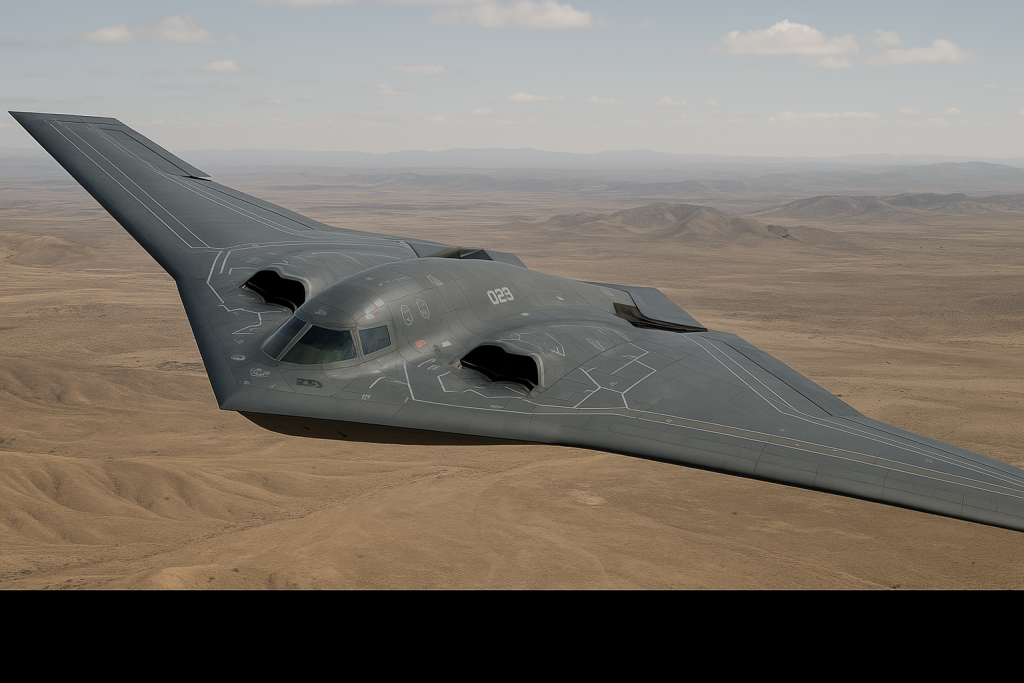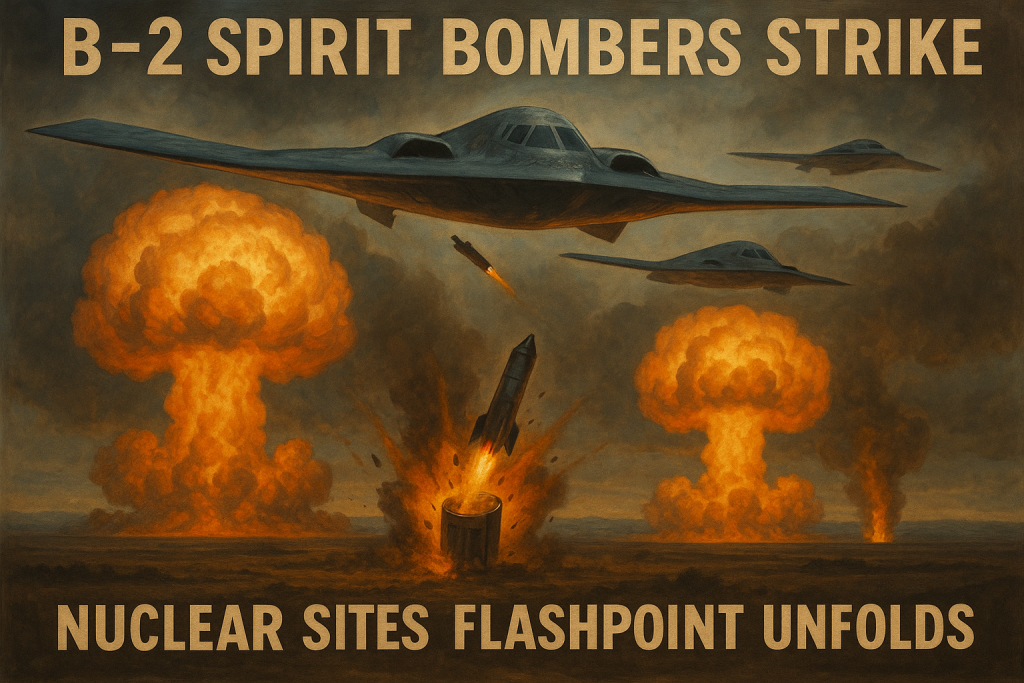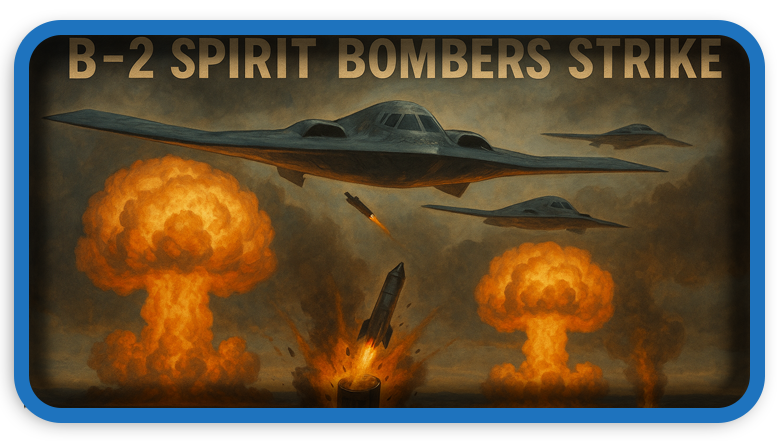⏲️ Estimated reading time: 5 min
In a dramatic turn of global affairs, U.S. B-2 Spirit stealth bombers have reportedly targeted three Iranian nuclear sites on June 22, 2025. The precision strikes aim to hinder Tehran’s nuclear ambitions, escalating tensions in the volatile Middle East region.
✈️ B-2 Spirit in Action: A Stealth Precision Strike on Iran
On the early morning of June 22, 2025, the world woke to news of a major military action in the Middle East. According to multiple regional and defense sources, U.S. Air Force B-2 Spirit stealth bombers launched a coordinated attack on three Iranian nuclear facilities believed to be critical components of Iran’s uranium enrichment and weaponization efforts.
This marks a pivotal moment in Middle Eastern geopolitics, significantly escalating long-standing tensions between Iran and the United States and its allies.

🎯 The Targets: What Was Hit?
Although official confirmation remains limited, preliminary reports from intelligence agencies and journalists in the region suggest that the targeted sites included:
- Natanz Nuclear Facility – Iran’s primary enrichment center.
- Fordow Underground Complex – A fortified nuclear research hub.
- Isfahan Nuclear Research Center – Known for heavy water and advanced centrifuge development.
These targets were reportedly chosen due to their strategic significance in Iran’s nuclear fuel cycle and their role in recent enrichment efforts, which have raised alarms in Washington and European capitals.
🕵️ Why the B-2 Spirit?
The Northrop Grumman B-2 Spirit, dubbed “the most feared bomber ever built,” is a stealth, heavy-penetration strategic bomber capable of deploying both conventional and nuclear weapons. Its low observable stealth technology allows it to evade sophisticated radar systems, making it the aircraft of choice for high-risk, high-value targets deep within enemy territory.
Key Features:
- Stealth profile (virtually invisible to radar)
- Intercontinental range with aerial refueling
- Capability to deliver precision-guided munitions
- Can strike without detection and return undetected
This operation showcased the B-2’s strategic value and why it remains a cornerstone of U.S. air superiority in contested regions.
🤝 Allied Coordination and Tactical Execution
Reports suggest that the mission was coordinated with U.S. allies, possibly involving intelligence sharing and aerial surveillance from NATO assets. While Israel has not officially commented, speculation remains high about its role in planning or support, given its vocal opposition to Iran’s nuclear ambitions.
The U.S. likely employed satellite reconnaissance, airborne early warning systems (AWACS), and possibly drone support to ensure mission success while minimizing collateral damage.
🔇 Official Silence and Iran’s Likely Response
As of this writing, neither the U.S. Department of Defense nor the White House has issued a formal statement. The silence may be strategic, as diplomatic channels brace for a potential regional backlash and prepare for de-escalation or defense against retaliation.
Meanwhile, Iranian state media has not acknowledged the strikes, but air traffic disruptions, closed airspace, and military movements in Tehran and Isfahan suggest emergency mobilization and strategic reassessment.
🌍 International Reactions: Fear, Diplomacy, and Condemnation
The international community remains divided:
- European Union leaders have expressed “grave concern” and called for emergency diplomatic talks.
- Russia condemned the attack as a “flagrant violation of sovereignty.”
- China urged restraint, emphasizing the need for dialogue over force.
- Israel has remained silent but is expected to express strong support if the strikes curb Iran’s enrichment activities.
The UN Security Council is expected to convene within the next 48 hours to address the situation.

⌛ A Long-Brewing Crisis
This strike is the latest episode in a decade-long standoff over Iran’s nuclear capabilities:
- 2015: Iran signs the Joint Comprehensive Plan of Action (JCPOA).
- 2018: U.S. withdraws from JCPOA under Trump.
- 2021–2024: Iran accelerates uranium enrichment beyond JCPOA limits.
- Early 2025: Satellite images and intelligence reports suggest near-weapons-grade uranium levels.
With diplomacy stagnating and Tehran showing defiance, this military response was seen by some analysts as inevitable.
🧨 What’s Next?
The situation remains fluid and highly volatile. Key questions moving forward:
- Will Iran retaliate militarily or via proxies like Hezbollah or militias in Iraq?
- Can diplomatic channels be re-engaged, or is this a point of no return?
- Will global oil markets and shipping lanes be affected?
Global investors, energy markets, and political leaders are bracing for further instability in the Strait of Hormuz, a critical oil transit chokepoint.
📈 Strategic Significance of the B-2 Strike
This mission reinforces several strategic messages:
- U.S. readiness and technological dominance remain unmatched.
- The B-2 Spirit continues to be a symbol of preemptive deterrence.
- The West will not tolerate unchecked nuclear proliferation, especially in unstable regions.
The strike also reignites the debate on preemptive military action versus diplomacy in dealing with nuclear-ambitious regimes.
🔔For more tutorials like this, consider subscribing to our blog.
📩 Do you have questions or suggestions? Leave a comment or contact us!
🏷️ Tags: B-2 Stealth Bomber, Iran, Nuclear Sites, U.S. Military, Middle East, Geopolitics, Airstrikes, U.S. Air Force, Fordow, Natanz
📢 Hashtags: #B2Spirit, #IranNuclear, #USMilitary, #MiddleEastCrisis, #Geopolitics2025, #Natanz, #Fordow, #AirStrike, #IranNews, #GlobalSecurity
🔚 Strategic Outlook Ahead
As we await official confirmations and diplomatic developments, the June 22 B-2 bomber strikes on Iran may become a turning point in the balance of power across the Middle East. The stealthy precision of the B-2, coupled with the gravity of the targets, signals that when diplomacy fails, deterrence takes flight.
Whether this marks the beginning of a broader conflict or a tactical pause in nuclear ambitions, history will remember this as a defining moment in 21st-century warfare.
Only logged-in users can submit reports.
Discover more from HelpZone
Subscribe to get the latest posts sent to your email.

